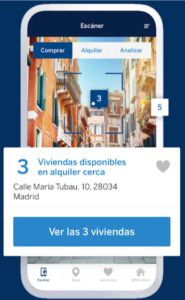In this post, we look at Valora View, a mobile application created by Plain Concepts for BBVA. This app helps customers find properties for rent or sale with Augmented Reality, 2D heat map features, and more. All using .NET and Xamarin!
BBVA
BBVA has a core focus on developing innovative products and services for its digital channels. Especially its mobile platforms which are the fastest growing among our 75m customers. A great example of this output is the naming of the BBVA mobile app as the “Best in the World”, for the second year running, by independent research analysts Forrester. This recognition comes a few months after Forrester also gave BBVA the highest score for mobile banking in Europe, with our Turkish business Garanti BBVA securing second place.
BBVA took the top spot thanks to “a superb balance between useful functionality and excellent user experience.” The report added that BBVA “customers can complete a wide range of tasks through the app, which also offers a range of next-generation features such as BBVA Valora.
Valora View
So what is BBVA Valora? In short, it is a service designed to help people make more informed decisions about buying or renting a property with the focus on saving time, money and stress. BBVA Valora View mixes Big Data, Xamarin and Augmented Reality to transform the way people find their new home.
Before the Internet revolution, the common process to house hunting was walking through the desired neighborhood looking for rent or for sale signs. BBVA Valora View is a digital evolution of this approach, using augmented reality to show properties for sale or rent on the person’s phone. But Valora then takes things to the next level, interweaving big data, Xamarin and AI tools to give people real-time information about the house and the neighbourhood.
For example, Valora will tell you to give you neighbourhood statistics, but also tell you insights like what the house could be worth in the future and what a good bidding price will be – based on data from the area. It can also help you understand elements like renovation costs, insurance, and of course offers mortgage calculators and an online mortgage application option.
BBVA entrusted Plain Concepts, a Microsoft Gold Partner, to develop the Valora View app. Plain Concepts provided experts in Xamarin and Augmented Reality to help develop the project and to successfully meet the ambitious objectives of this innovative solution.
Big Data
 BBVA Valora View in many ways summarizes the ambitions behind BBVA’s digital transformation – to create opportunities by supporting people to make the right decision for them. It does this by mixing both financial and non-financial data to provide technology-driven insights that are actionable and disruptive to the sector.
BBVA Valora View in many ways summarizes the ambitions behind BBVA’s digital transformation – to create opportunities by supporting people to make the right decision for them. It does this by mixing both financial and non-financial data to provide technology-driven insights that are actionable and disruptive to the sector.
“BBVA Valora View has been a huge success. On the first day alone we had over 8.000 downloads, and one year since its launch we have surpassed 80k downloads. On an average session, a user dedicates over 5 minutes to surf the app looking for detailed information and customized calculations.” says Gabriel González, Digital Product Manager at BBVA.
Augmented Reality
 The result of the Big Data input is shown with Wikitude. An Augmented Reality framework in BBVA Valora View redefining the experience of finding a house. Wikitude presents in an AR view on a mobile device the georeferenced data the app obtains with information and statistics about the house.
The result of the Big Data input is shown with Wikitude. An Augmented Reality framework in BBVA Valora View redefining the experience of finding a house. Wikitude presents in an AR view on a mobile device the georeferenced data the app obtains with information and statistics about the house.
The decision to buy a home is always complex, and in many cases, people are faced with the dilemma of whether it is more convenient to buy or rent. The tool calculates the different costs and investments needed and offers to the user information about which of the two options is more advantageous.
Xamarin.Forms
Xamarin.Forms allows BBVA to code the application programmes once and share it across iOS and Android platforms seamlessly. Compare this to working in the native environments of the two platforms where the logic must be implemented once in Java for Android then the same logic implemented a second time in Swift for iOS.
One of the coolest aspects of Xamarin.Forms is that it doesn’t try to force commonality where none exist. Both Android and iOS have UI and SDK features that are distinct to each platform’s appearance and behavior. So, the result is that iOS apps feel like iOS and Android apps feel like Android. It has been possible to focus all efforts in building the app features once and then shipping it. Taking advantage of Model-View-ViewModel best practices allows maximizing the code sharing between both platforms.
AppCenter
During the development and testing phases, AppCenter was presented as the best platform to build, test, and distribute the app. The simplicity to configure a build and be able to distribute it quickly was very important for the project allow us to implement an agile lifecycle.
AppCenter features for Analytics and Diagnostics was essential to detect issues, the full stack traces and the information needed to solve them quickly. Testing features made possible to define user interface tests with Xamarin.UITest for some critical scenarios and run them in a lot of devices to detect if there were some device specific issues that must be considered.
See BBVA In Action
More info at Microsoft





Deja un comentario